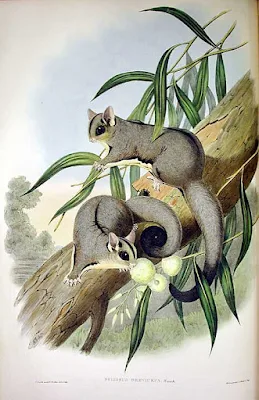20 Interesting Facts About Sugar Gliders
- Sugar gliders are small, nocturnal marsupials of the possum family. They are named so because of their gliding ability and fondness for sweet foods.
- Sugar gliders are one of the three living gliding mammals besides flying squirrels and colugos (flying lemurs). These marsupials can catch flying insects while gliding.
- A soft membrane between the front and back legs acts like a parachute in sugar gliders. It assists the animal in gliding up to half the length of a soccer pitch (around 165 feet) in a single leap. The sugar glider controls the direction of this long glide through its bushy tail, which performs the function of a rudder.
- Sugar gliders are present in New Guinea (Indonesia and Papua New Guinea) and Australia, where they are the most common and widely spread Australian gliders. Their habitat includes woodlands, open forests, and wet forests.
- Sugar gliders are native to mainland Australia but were introduced to Tasmania from Victoria during the early 1800s. However, these mammals have proved to be an invasive species here and are responsible for destroying 79% of nests and 65% of breeding females of swift parrots annually. It is a critically endangered parrot of southeastern Australia that breeds only in Tasmania. (Source)
- Sugar gliders and flying squirrels look identical and can glide through trees. Both are nocturnal and have big eyes for better night vision. However, they are entirely different animals, mainly due to their reproductive methods. Sugar gliders are marsupials that keep their newborn in the pouch while flying squirrels are placental mammals that develop inside the mother’s body before birth.
- Sugar gliders have a mutually beneficial relationship with the native eucalyptus tree. They get shelter and food (sap and insects) from this tree. These marsupials also protect this woodland tree as each family consumes nearly 200 kg of Christmas beetles, a dangerous pest on eucalypt trees, annually. (Source)

Sugar gliders protect eucalyptus from pests - Sugar gliders were once considered “least concern” due to their healthy population and wide range. However, a study in 2020 divided them into three distinct species: sugar gliders, savanna gliders, and Krefft’s gliders. According to the new distribution, sugar gliders are limited to the coastal region (east of the Great Dividing Range) in southeastern Australia, while the savanna and Krefft’s gliders are predominant in the northern and eastern parts of Australia. This discovery has made the conservation status of sugar gliders questionable because they live in tree hollows and face frequent bushfires. (Source)
- Sugar gliders generally have grey fur and white underbellies that provide camouflage against arboreal (tree-dwelling) and ground predators. They usually have black stripes on their head.
- Sugar gliders communicate and identify each other using the secretion of scent glands on their skin. Females have scent glands in their pouch. These mammals also use urine to mark their territory.
- Sugar gliders produce several sounds for various purposes. These include crying (when separated from cage mates), purring (when feeling content), singing (by females with young), crabbing (angry), barking, etc.
- The lifespan for sugar gliders is 3 to 9 years in the wild, while they can live for 10 to 15 years in captivity, depending on their care. The oldest known sugar glider lived for over 17 years.
- Winter temperatures can fall below freezing in some parts of their range. In these circumstances, sugar gliders keep themselves warm by sleeping huddled together. They may also enter torpor, a short hibernation-like state, to conserve energy during winter. The average torpor duration in sugar gliders is nearly 7 hours in captivity and 13 hours in the wild.
- Female sugar gliders give birth to one or two babies, joeys, after a gestation period of 15 to 17 days at least once a year. Babies remain in the pouch for 70 days and stay with their mothers for up to 10 months.
- Sugar gliders are omnivorous animals. Their diet includes insects, arachnids, nectar, pollen, sap, gum, honeydew (a sugary substance on plants excreted by aphids or fungus), etc. The diet changes according to season as insects are generally available during spring and summer. They may also take part in the pollination of native Australian flowering plants.
- Several body parts assist sugar gliders in getting and digesting this wide range of food. They chew the bark of a tree using their long lower incisors, while their elongated fourth digit assists in extracting insects from narrow openings. Their large caecum assists in digesting complex carbohydrates present in gum.
- Sugar gliders are social animals that live in colonies of six to ten adults. Two dominant males mark the territory (up to 1 hectare) and other members of the colony with secretion from scent glands.
- Sugar gliders secrete a white, oily substance with an odor of sour fruit from their paracloacal glands. It happens when the animal urinates, defecates, or is frightened.
- Observations have proved male parental care in both captive and wild sugar gliders. Male caring protects the young from hypothermia when the mother forages. (Source)
- Sugar gliders remain very clean and odorless in normal conditions due to their grooming habits. The odor from pet animals is from urine in and around their cage. Keeping them clean in captivity prevents unsanitary conditions and skin infections. Otherwise, they start excessive grooming that can result in self-mutilation and fur pulling.



Comments
Post a Comment